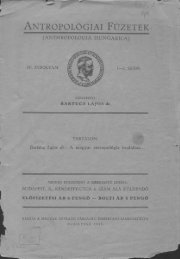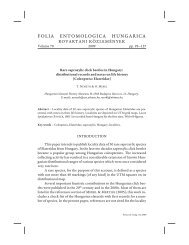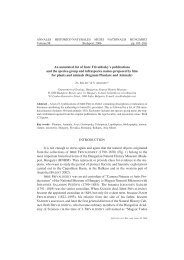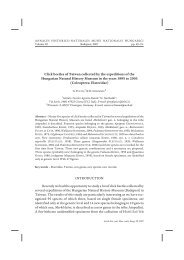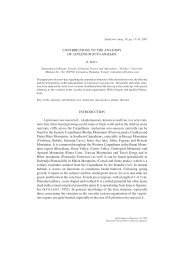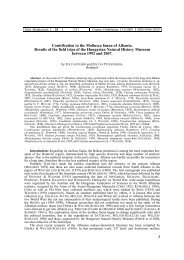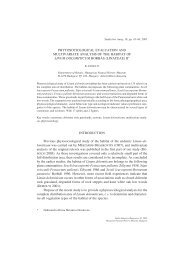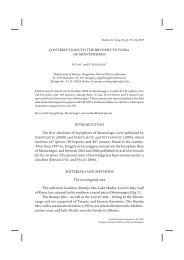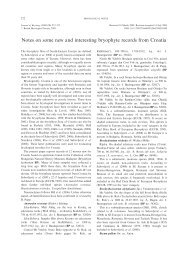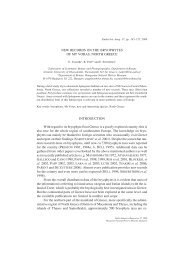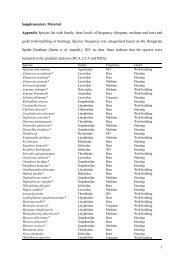THE GENUS SCHISTIDIUM (GRIMMIACEAE, MUSCI) IN HUNGARY ...
THE GENUS SCHISTIDIUM (GRIMMIACEAE, MUSCI) IN HUNGARY ...
THE GENUS SCHISTIDIUM (GRIMMIACEAE, MUSCI) IN HUNGARY ...
Create successful ePaper yourself
Turn your PDF publications into a flip-book with our unique Google optimized e-Paper software.
78 ERZBERGER, P. and SCHRÖDER, W.<br />
Exothecial cells in central part of urn predominantly oblong, up to<br />
60 μm; peristome teeth 300–450 μm long, in freshly deoperculate capsules<br />
stellate-straight, scarcely twisted, orange; hair-point coarse, of<br />
variable length; urn usually with 0–4(6) stomata at base, but sometimes<br />
more, pores rudimentary or lacking; central strand distinct (> 6 cells);<br />
spores 8–11 μm<br />
(calcareous rocks, often on concrete)<br />
Exothecial cells predominantly isodiametric and transversely elongate;<br />
peristome teeth 300–710 μm long, strongly curved, bent clockwise<br />
and twisted; stomata with distinct pores present; hair-point fine,<br />
of variable length; central strand absent or narrow (< 6 cells); spores<br />
(9)11–15(19) μm<br />
Peristome teeth forming a dome above the urn mouth, (410)450–700 μm<br />
long, very finely and longly pointed, red; columella not falling with the<br />
lid; plants often black, hair-point absent or short (0–0.18 mm)<br />
S. trichodon (moist calcareous rocks)<br />
) urn never cyathiform, length / width ratio 1.6–2.4, plants brownish, never<br />
jet-black<br />
S. trichodon var. nutans<br />
) urn often cyathiform, length / width ratio 1.3–2.1, plants often jet-black<br />
S. trichodon var. trichodon<br />
Peristome teeth reflexed or spreading, 320–710 μm long, their points<br />
may be bent upwards, but never form a dome, red-orange; columella<br />
falling with the lid<br />
Urn 0.7–1.0 mm long and 0.5–0.65 mm wide, exothecial cells quadrate<br />
to transversely rectangular, in regular perpendicular rows, peristome<br />
teeth 320–400 μm; costa strongly papillose on abaxial side in upper<br />
half of leaf, papillae increasing in length towards leaf apex (up to 9–11<br />
μm high), leaf margin strongly and irregularly denticulate to serrate in<br />
upper part of leaf; perichaetial leaves 0.5–0.8 mm wide, small plants<br />
(shaded siliceous, rarely calcareous rocks)<br />
Urn 0.9–1.35 mm long and 0.5–0.85 mm wide, exothecial cells isodiametric,<br />
but pattern less regular; peristome teeth 400–700 μm; leaf margin<br />
finely denticulate or rarely smooth, costal papillae lower; perichaetial<br />
leaves 0.8–1.5 mm wide, medium-sized plants<br />
(calcareous or siliceous substrata)<br />
Studia bot. hung. 39, 2008



